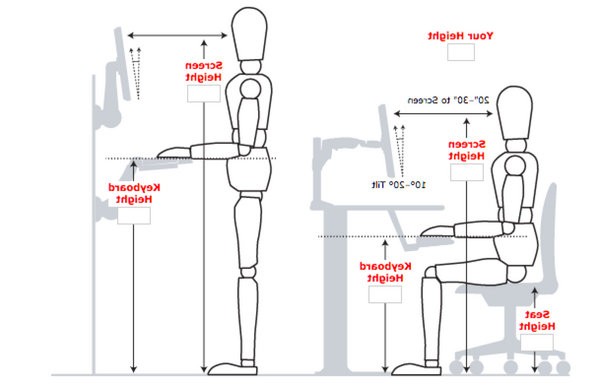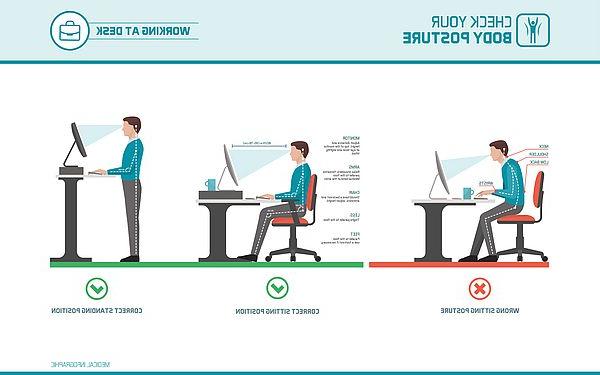符合人体工程学的政策
Applicable to all 沃拉沃拉大学 employees, 包括教师, 在日常工作活动中遇到人体工程学风险因素的员工和学生.
- Provide a safe working environment for all faculty, staff and students.
- 通过预防因接触危险因素而引起的肌肉骨骼疾病,优化员工的健康和安全.
- Ensure early intervention once a musculoskeletal injury has been reported.
- Enhance employee morale, productivity and comfort in the workplace.
This policy does not include injuries caused by slips, 旅行, 瀑布, 交通事故或其他类似事故.
This policy covers musculoskeletal disorders of the 回来, upper and lower extremities and includes 回来 injuries, 累积性创伤障碍, 重复性劳损障碍, 等. 它适用于Walla Walla大学每天需要超过四(4)小时以下工作的所有工作:
- 重复的手、手臂或肩膀动作,
- Fixed or awkward position (working with wrists bent, 跪着, 背部扭曲或弯曲, 头顶上的工作, 弯腰),
- 坐姿/站姿不佳;
- 过度的到达,
- 使用振动或冲击设备;
- 手动搬运25磅或以上的重物,
- 过度使用武力;
- 联系 stress (resting wrist/forearm against a sharp edge),
- 工作站或椅子调整不当.
可能对员工的肌肉骨骼系统造成伤害的物理压力源和工作环境.
的 following activities are recognized as important 风险 factors, especially when performed frequently and/or in combination with each other:
持续做同样的动作会导致肌肉和肌腱疲劳和拉伤, especially when performed frequently over a prolonged period of time. 过度使用, 疲劳的肌肉和肌腱不能从重复动作的影响中恢复,如果在两次运动之间没有足够的恢复时间. 对于大多数重复性劳损,疾病的发展经历三个损伤/疾病阶段. 重复动作的效果会随着笨拙的姿势和用力的动作而增加.
例子:
- Intensive data entry requiring rapid, repeated keying actions
- 手工物料搬运活动
在有压力或非中性的身体姿势下工作,由于发生的力量或压力的量,会使身体受影响的部分疲劳或压力.
例子:
- 弯曲或弯曲手腕工作
- 伸展双臂完成任务
- Prolonged holding of a single posture or position
- Lifting, lowering, or handling objects when the 回来 is bent or twisted
- Sudden, jerking movements made during the work process
- 频繁地或长时间地伸手去拿东西,尤指在肩膀以上
- 经常弯腰或蹲下
给肌肉施加过多的负荷, 肌腱, 韧带和关节增加了对身体的需求,以维持增加的努力, such as greater muscle exertion and physiological changes. This includes lifting, pushing, and pulling motions.
例子:
- Using small or narrow tool handles that lessen grip capacity
- Using the index finger and thumb in a pinch grip to forcefully grip objects
- Twisting, bending or stooping at the waist to lift and lower loads
- Lifting, loading or lowering objects that do not have adequate hand-holds
放置前臂, 手腕或手指反复或持续接触坚硬或尖锐的物体/表面或无衬垫, narrow tool handles can interfere with proper nerve function and blood flow.
例子:
- Pressing forearms or wrists against sharp/hard desk edges when keying or writing
- Using tools that press into the base of the palm
- 用手掌当锤子的
局部振动暴露是由手与振动物体接触产生的, 比如电动工具. 当站着或坐在卡车或重型机械等振动环境中时,会发生全身振动暴露, or while using heavy equipment such as jackhammers.
For most repetitive strain injuries, the disease progresses through three stages:
轻微的疼痛或疲劳,休息后会消失,一般不会影响工作之余的生活方式, 在很大程度上. 这一阶段可能持续数周或数月, but is generally reversible if the cause is identified and removed.
更剧烈的疼痛, 疼痛, 刺痛, numbness or tiredness that develops early in the working day, 夜间持续时间更长, 甚至影响到在家里的活动.
Symptoms become continuous, even during complete rest. Often, the worker can no longer carry out ordinary light tasks at work or at home. At this stage, recovery may take years if it occurs at all.

一个单独的工作站应该为操作者提供一个舒适的坐姿,足够灵活, 使用和观察屏幕, keyboard and any paper document referred to while keying. Some general guidelines to minimize fatigue include:
椅子的座位和靠背应该支持一个舒适的姿势,允许偶尔改变坐姿. Chair height and 回来rest angle should be easily adjustable. 脚凳可能是必要的.

When using the keyboard, the upper arm and forearm should form a right angle. 双手应与前臂在一条合理的直线上,使用手腕托. Long or unnaturally high reaches should be avoided. 键控时也应避免使用扶手.
当整个脚底可以搁在地板上或脚凳上,膝盖与臀部水平或略高于臀部时,椅子的高度是正确的. This allows blood to circulate freely in the legs and feet.
垂直调节的显示器使操作员能够选择最佳的观看位置. Eyes should be level or slightly below the top of the screen. 显示器应该居中,大约在一臂的距离(或者更近,以获得更好的视力)。.

的 table or workstation should suit the task to be done. It should be large enough for reference materials, 文件, 电话, 计算器或其他必要的项目,也允许不同位置的屏幕和键盘. 一个可调节的表面高度是一个优势.

- Top of monitor screen should be at eye level and 20-30" away.
- 手臂应该舒适地垂在肩膀上, close to body with forearms in a 90-degree alignment (neutral posture).
- 手腕要平. 键盘放在这里.
- 调整椅子,使臀部和腿成90度角,脚平放在地板上. 坐直身子.
- 使用抄写器保存文件.
- 每小时休息一下.

总是, individuals twist or strain to reach the keyboard or sit in odd contortions, 导致脖子, 回来, 或者手腕疼痛. 一些简单的工作站修改, 态势感知, 椅子意识可以防止问题的发生.
- 降低椅子的高度,这样你的背部就会碰到椅背,你会感到很舒服.
- Your feet should rest firmly on the floor slightly in front of you.
- 把键盘放在显示器前面. Your eyes should be at the same level as the tool bar.
- Keep the keyboard and mouse close to the edge of the desk.
- 键盘和鼠标的位置应该让你的手臂自然地垂在身体两侧, with wrists straight out in front while typing/mousing.
- 支持 your wrist and forearms with a gel pad or wrist support,
- 避免反复抓着鼠标,
- Keep frequently used items close - avoid re疼痛 for anything,
- 进行手腕、手指和手部的锻炼.
如果你觉得你的工作环境有问题,花点时间填写一下 Workstation Ergonomics Self-Evaluation Checklist.

如果您担心您的工作站可能有问题,或者已经经历了与人体工程学相关的不适, 你可以要求对你的工作区域进行评估. 要求评估:要求评估:
- 查看工作站调整列表
- 完成 Workstation Ergonomics Self-Evaluation Checklist
- 完成所有人机工程 安全训练课程 你已经被指派了
这个评估是为那些以前没有在沃拉沃拉大学做过人体工程学评估的人准备的.
一旦你完成 Workstation Ergonomics Self-Evaluation Checklist, Human Resources will schedule an assessment of your work area. 一旦完成, 将写一份报告,列出任何问题领域和改进建议. A copy of this report will be made available to your supervisor. 人力资源部将协助您对工作站进行任何修改.
This assessment is for those who have had a previous assessment done. You may want a re-check because your workstation has changed, 你的职责已经改变了, 或者你开始经历与人体工程学相关的不适,这是你以前没有经历过的.
请填写一份新的 Workstation Ergonomics Self-Evaluation Checklist. 人力资源部将安排对你的工作领域进行新的评估,并对任何问题领域和改进建议进行更新报告. A copy of the report will be made available to your supervisor. 人力资源部将协助您对工作站进行任何修改.
如果你觉得你的工作环境有问题,花点时间填写一下 Workstation Ergonomics Self-Evaluation Checklist.


- Immediately inform Human Resources, of any ergonomic-related discomfort. Early reporting is important to prevent injuries from occurring or becoming worse.
- 对工作站进行人机工程学自我评估,报告不足之处并安排评估. 的 Workstation Ergonomics Self-Evaluation Checklist 并提供了一个简单的工作站调整列表,以帮助评估您的需求.
- Be responsible for correct use of the equipment provided by your employer.
- 参与必要的人体工程学设计 安全培训.
- 执行 简单的伸展或运动 throughout the day, according to ability, to reduce stress.
- 遵守人体工程学政策,遵循推荐的工作方法,防止重复性劳损和不适. Non-compliance is subject to disciplinary action. 沃拉沃拉大学 is responsible for the safety of its employees. 正因为如此,员工必须遵守对工作场所变化的建议.
- 确保适当的工作方法. When considering an employee's regular job assignment, 工作节奏和工作流程都应该被审查,以避免任何一个员工和他/她的特定职位过度重复的工作.
- 鼓励员工及时向人力资源部报告与人体工程学相关的不适迹象和症状,并填写 Workstation Ergonomics Self-Evaluation Checklist,并跟进合规情况.
- 适应 employee work restrictions established by their health care provider.
- 监督人力资源部建议的现场整改和改进的实施. Upon completion of Human Resource's workstation assessment, 您将收到对员工工作站进行更改的建议副本.
- Non-compliance is subject to disciplinary action. 沃拉沃拉大学 is responsible for the safety of its employees. 正因为如此,员工必须遵守对工作场所变化的建议. 如有违规行为,人力资源部将与主管或部门主管进行沟通.